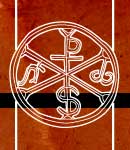
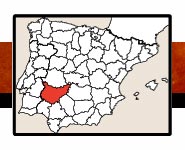

 |
 |
||
 |
|||
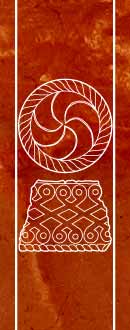 |
(40)/A-BA/BADA-JerCa-40.jpg) |
-55/BOOK-cort-40.jpg) |
 |
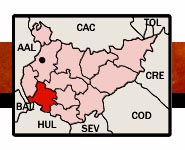 |
||
 |
|||
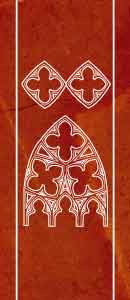 |
ACCESO A JEREZ DE LOS CABALLEROS : Desde la A-66 se recomienda salirse por la carretera de Zafra y coger la carretera de Fregenal de la Sierra y Jerez de los Caballeros (EX101 primero y EX112 después) o bien la N-435 desde Badajoz o Huelva. En la parte alta se ubican los monumentos. ACCESO PARA MINUSVÁLIDOS : Por un lado aunque el pavimento es bueno las cuestas obligan a disponer de ayuda. Las escaleras dificultan el acceso a las iglesias, y la alcazaba solo es visitable parcialmente. |
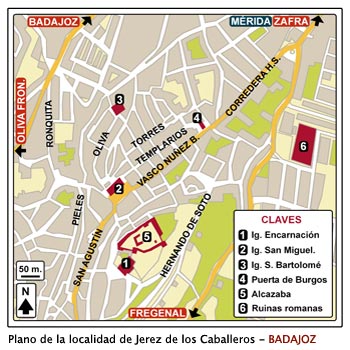 |
ACCESS TO JEREZ DE LOS CABALLEROS : From the A-66 it is recommended to exit by Zagra highway and take the Fregenal de la Sierra and Jerez de los Caballeros road (EX101 first and EX112 after) or the N-435 from badajoz or Huelva. In the high part of the city the monuments are located. ACCESS FOR HANDICAPPED : Although the pavement is good, the slopes require assistance. The stairs hinder access to churches and the citadel is only partially accessible. |
||||
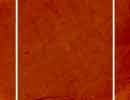 |
 |
CASTILLO (BURGUILLOS DEL CERRO) En lo alto del cerro que domina la localidad de Burguillos del Cerro se ubica el castillo medieval, se remonta al siglo XIII, es notable la torre de homenaje y su amplio patio de armas, el acceso se realiza por un arco gótico de sillería, el resto es una construcción de mampostería, aun conserva algunas almenas. VISITA : burguillos@dip-badajoz.es |
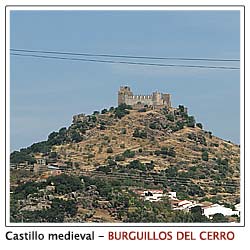 |
CASTLE (BURGUILLOS DEL CERRO) At the top of the hill that overlooks the town of Burguillos del Cerro is the medieval castle, dating back to the 13th century, it is remarkable the tower of tribute and its large courtyard, the access is made by a Gothic arch of ashlar masonry, the rest is a rubblework building, still retains some battlements. VISIT : burguillos@dip-badajoz.es |
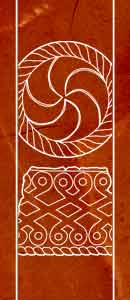 |
ENTRADAS Y HORARIOSEl teléfono de contacto para la visita al yacimiento es el 620.855.985. La visita es gratuita, y el horario de verano (15 junio-30 septiembre) es los viernes de 18:00-20:00, sábados y domingos es de 9:30-13:00 y en invierno los viernes es de 16:00-18:00, sábados y domingos es de 10:30-14:00. ACCESOAcceso por N-345 (Badajoz-Huelva), donde se encuentra Higuera la Real, Capote se ubica justo en el límite provincial con Huelva. ACCESO PARA MINUSVÁLIDOSEl centro de Interpretación tiene pasarelas de acceso si es apto para minusválidos; pero la visita al castro es complicada y no recomendable para sillas de ruedas. |
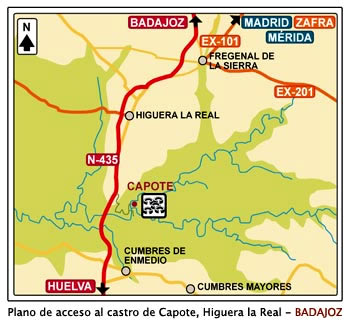 |
TICKETS AND TIMETABLEThe contact phone number for the visit the site is 620.855.985. The visit is free. Summer timetable (June 15 th to September 30 th ) is on Friday from 6 pm to 8 pm; Saturdays and Sundays is from 9,30 am to 1,30 pm and winter timetable on Friday is 4 pm – 6 pm; Saturdays and Sundays is 10,30 am – 2 pm. LOCATIONAccess by the N-345 (Badajoz-Huelva), where Higuera la Real is located, Capote is placed right on the provincial border with Huelva. ACCESS FOR THE HANDICAPPEDThe Archaeological Point has access gateways, if it is suitable for handicapped; but the visit of the site is more difficult with wheelchair and not recommended. |
||||
 |